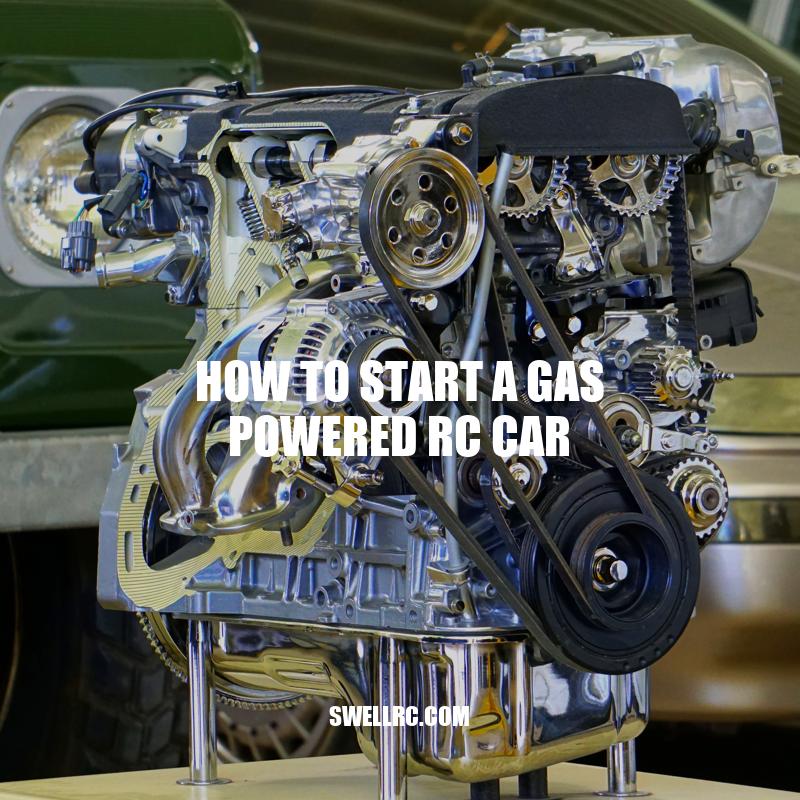Guide to Starting a Gas-Powered RC Car
Starting a gas-powered remote-controlled (RC) car is a thrilling experience that can be both fun and challenging at the same time. There’s a lot to consider when you’re starting an RC car, from assembling the car correctly to fueling the engine and ensuring all components are in good working condition. While it may seem daunting, starting a gas-powered RC car can be easy with the right knowledge and approach. In this article, we will provide step-by-step instructions to help you start your gas-powered RC car with ease. By following these simple steps, you’ll be well on your way to enjoying the thrill of racing in no time. But before we dive into the process of starting a gas-powered RC car, let’s take a quick look at some of the things you need to know before you get started. First, you need to ensure that you have assembled the car according to the instruction manual. You also need to prepare the car and ensure that everything is in good condition before starting the engine. Once you’ve ticked all the boxes, it’s time to start your engine, and we are here to guide you every step of the way.
Assembling the Car
Before starting your gas-powered RC car, it’s crucial to ensure that your car is properly assembled according to the manufacturer’s guidelines. Here’s what you need to do:
- Ensure that all screws, nuts, and bolts are tightly secured
- Check that the fuel tank and air filter are both clean and in good condition
- Charge your battery to ensure it’s fully charged
- Make sure that the engine is correctly mounted
- Check that the wheels, bearings, and springs are securely in place
If you have any doubts about your car’s assembly, it’s always best to consult the instruction manual or an expert in the field. Several websites offer helpful guides and resources that provide detailed instructions to help you assemble your RC car professionally.
Some of the websites that offer valuable resources include:
- RCCars.com
- HobbyTown.com
By ensuring your car is correctly assembled, you can have peace of mind knowing that your RC car is in good working condition and is ready to race.
How to Make an RC Car Step by Step?
- Gather materials such as body, motor, wheels, and radio control system.
- Assemble the chassis, which is the bottom part of the car.
- Attach the motor and wheels to the chassis.
- Install the radio control system, which allows remote control of the car.
- Add the body, which is the outer shell of the car.
- Test the car to make sure everything works properly.
There are many websites and products available that offer detailed instructions and materials for making your own RC car, including hobby shops and online retailers.
Preparing to Start the Engine
Before you start your gas-powered RC car engine, here’s what you need to do to be prepared:
- Find a flat and clean surface where you can operate your car safely
- Ensure that you have fuel available; most gas-powered RC cars run best on a mixture of gasoline and oil.
- Check that you have the right tools available; you’ll need pliers, an air filter oil, and fuel mixture to get started.
- Have a good quality glow plug handy to use in case you need to replace the current one
Interesting fact: Did you know that some oil brands can cause a significant difference in the performance of your RC car?
To ensure optimal performance, Shell, AMSOIL and VP Racing are some of the brands recommended by top RC car enthusiasts.
RC Car Fuel Mixing Chart – Ratio Guide
Here is a table showing the recommended gas to oil mix ratios for different model engines:
| Model Engines | Fuel Mixture Ratios |
|---|---|
| 16:1 | For break-in procedure only. |
| 32:1 | Recommended for local racing or bashing. |
| 40:1 | Recommended for high-performance racing, ambient temperatures above 75°F (24°C) and high-speed runs over longer distances. |
| 50:1 | Recommended for high-performance racing, ambient temperatures around 75°F (24°C) and extended high speed runs like hill climbing or extended on-road running. |
Using the right fuel and oil mixture ratio helps your engine last longer and run more efficiently. Make sure you always refer to the manufacturer’s recommendation to get the best engine performance.
How do you break in a RC gas engine?
Breaking in a RC gas engine is a crucial step in ensuring its longevity and optimal performance. Here are some steps to follow when breaking in your RC gas engine:
- Start by running the engine at half throttle for the first few tanks of fuel. This allows the engine to heat up gradually and helps the parts and components to settle in.
- After the first few tanks, gradually increase the throttle and run at full throttle for short bursts. Do this for several tanks of fuel before running the engine at full throttle for extended periods of time.
- During the break-in process, pay attention to any unusual sounds or vibrations. If you notice any, stop running the engine immediately and investigate the issue.
- Be patient and take your time. Rushing the break-in process can lead to premature wear and tear or even permanent damage to the engine.
If you have any questions or concerns about breaking in your RC gas engine, consult the manufacturer’s instructions or contact their customer support for guidance. Additionally, websites such as RC Universe or RC Groups are great resources for troubleshooting and advice from fellow RC enthusiasts.
Starting the Engine
Now that you have assembled and prepared your gas-powered RC car, you are ready to start the engine. Here is a step-by-step guide to help you start your car’s engine safely and efficiently:
Step 1: Turn on the Transmitter and Receiver
Make sure your transmitter and receiver are turned on and that the throttle on your transmitter is in the lowest position.
Step 2: Turn on the Ignition Switch
Turn on the ignition switch to energize the spark plug and light up the glow plug.
Step 3: Prime the Fuel Line
Press the primer bulb several times to build up fuel pressure in the fuel line; this action ensures that the engine gets the proper mixture of air and fuel.
Step 4: Set the Choke
Set the choke at a fully closed position before starting the engine, which will create a rich fuel-air mixture to help the engine start.
Step 5: Pull the Pull-Start Cord
Grab the pull-start cord and give it a firm pull to start the engine.
Pro tip: Make sure the fuel tank holds enough fuel to keep the engine running. If the fuel tank is almost empty, the engine will not start.
As a beginner, you can purchase an RC car starter box, such as the Dynamite2-Speed RC Starter Box, to start your engine quickly and easily. Additionally, some websites provide video tutorials on how to start your RC car engine, such as YouTube and RC Driver. Using these resources will give you the confidence you need to start your RC car engine and have a great time racing.
How do you start a gas powered RC car?
To start a gas powered RC car, follow these simple steps:
- Make sure the car is properly fueled with gas and the glow plug is connected.
- Turn on the transmitter and receiver to connect them.
- Prime the engine by pushing fuel into the carburetor with a primer bulb, until you see gas coming out of the carburetor overflow.
- Attach the glow plug ignitor and hold it on the glow plug for a few seconds to warm it up.
- Start the engine by pulling the starter cord, or using a starter box.
For more tips and tricks on RC cars, check out websites like RC Universe or products such as the book “The RC Handbook” by Scott Fitzgerald.
Adjusting the Engine
Once you have started the engine, the next step is to make sure it is running correctly. Here are the steps to adjust your engine, so your car idles at a stable speed:
Step 1: Let the Engine Warm Up
Let your engine idle for a few minutes before adjusting the carburetor to ensure that the engine warms up.
Step 2: Adjust the Idle Screw
Turn the idle screw at the side of the carburetor until the engine is idling as smoothly as possible.
Step 3: Adjust the Low-Speed Needle
Using a screwdriver, adjust the low-speed needle and make small changes until you find the optimal idle speed; often the indicator is when you hear a crisp, popping sound.
Step 4: Adjust the High-Speed Needle
The high-speed needle controls your engine’s main fuel mixture. The ideal air/fuel ratio will ensure that your engine runs smoothly without over-revving.
Pro tip: It’s good practice to mark the adjustments on the carburetor, so you can quickly find the settings that work for your car in the future.
There are some online forums and websites such as The RC Network and RC Universe that specialize in the RC car community. These communities provide a wealth of information, knowledge, and shared experiences relating to this hobby. Educational videos on YouTube, such as ‘Advanced Tuning Tips and Tricks – Engine Carburetor and Clutch’ by AMain Hobbies are also helpful. Following respected members of the community like Adam Drake and Ryan Lutz on social media platforms such as Instagram allows enthusiasts to access the latest knowledge and strategies for the sport.
How do you tune an engine?
Here are the basic steps to tune an engine:
- Install performance parts, such as a cold air intake or an aftermarket exhaust system, to increase horsepower and torque.
- Adjust the air-fuel ratio by either adding or subtracting fuel until the engine runs smoothly.
- Change the spark plugs and wires to ensure proper ignition timing and to prevent misfires.
- Replace the distributor cap and rotor if the engine is equipped with these parts.
- Install a performance chip, which can adjust engine parameters for optimal performance.
If you need more detailed information, there are plenty of websites and products available that specialize in engine tuning.
Maintenance and Care
Taking proper care and maintenance of your car is essential in ensuring that it lasts for a long time. Here are some tips to keep your car in top shape:
Clean Your Car After Each Use
After use, clean the car with a damp cloth to remove any dust or dirt. Be extremely careful not to get water on any of the electronic parts.
Check All Nuts and Bolts
Regularly check all nuts and bolts to make sure they are tightened correctly to avoid any malfunction while driving.
Keep Your Engine Lubricated
Keeping your engine lubricated ensures that it runs smoothly and lasts longer. Frequent lubrication reduces friction and help increase the engine’s efficiency.
Replace Worn Out Parts
Replace worn-out parts, such as batteries and tires, as soon as possible to prevent damage to other parts of the car.
RC car enthusiasts can purchase aftermarket parts to upgrade and replace damaged parts for their RC car. Websites such as Horizon Hobby, Amain Hobbies, and Tower Hobbies offer parts and accessories for various RC models. It’s critical to only use replacement parts and accessories that are recommended by the manufacturer to guarantee that you maintain your vehicle’s optimal performance.
How do you take care of your car?
Taking care of your car is essential to maintain its longevity and prevent costly repairs. Here are some simple steps you can take:
- Change your oil and oil filter regularly
- Check your tire pressure and alignment
- Wash your car regularly and keep it clean inside and out
- Replace your air filter as needed
- Check and maintain your brakes
- Use a fuel system cleaner
For more detailed information on car maintenance, you can visit websites such as Car Talk or AutoZone, or consider using products like the Car Care Kit by Armor All.
Conclusion
Starting and maintaining a gas-powered RC car requires some effort, but it can be a fun and engaging hobby for car enthusiasts. Proper assembly, preparation, and starting are essential to ensure the car’s longevity and efficiency. Remember to maintain and clean the car after each use, check and tighten all bolts and nuts, lubricate the engine, and replace worn-out parts to keep the car running smoothly.
Whether you are a beginner or an experienced RC car hobbyist, with regular maintenance and care, you can enjoy the thrill of racing and take part in competitive events. So, if you are ready to kick-off your RC car adventures, follow our tips and enjoy your gas-powered ride!



